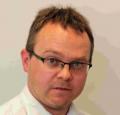
A new display board about the history of a Dorset airfield that played a vital role in war and peace has been unveiled on the 40th anniversary of the last jet flying out of the base – by the woman who controlled that final take off.
Tarrant Rushton airfield, near Badbury Rings, closed on Tuesday, September 30, 1980, after being the home of pioneering aviation research, manufacturing and services company Flight Refuelling since 1947.
In the control tower on that last day, Flight Refuelling air traffic controller Shirley Lockwood controlled the last flight out of the airfield when a former Royal Navy 1950s-built DeHavilland Sea Vixen jet took off for its new base at Hurn, now Bournemouth Airport, just before 10am.
Exactly 40 years on from that historic and sad last flight, Shirley came back to the former airfield – now returned to agriculture – to unveil a new display board next to the stone memorial in memory of the airfield’s personnel and unveiled in 1982.
Present were a representative of the Glider Pilot Regiment Society and as well as Nick Harding – who farms a large part of the former 300-acre airfield – and several invited friends with a keen interest in the airfield’s history.
Opened by the Royal Air Force in May, 1943, on a plateau above the Tarrant valley, the large three-runway airfield was home to 3,000 people and played a vital part in the Second World War, including towing gliders in the D-Day, Arnhem and Rhine crossing operations of 1944 and 1945.
Tarrant Rushton’s young aircrews flew low and in radio silence across occupied Europe, dropping secret agents, troops and weapons to Resistance forces from the south of France to the Low Countries and up to Norway.
Shirley Lockwood, who lives in Wimborne, said: “I found it very moving to return to Tarrant Rushton and it was a real privilege to unveil the new display board illustrating the airfield’s history from 1943 to 1980.
“The airfield played a very important part in the Second World War and the decades afterwards when Flight Refuelling carried out world-beating aviation research there. The new display board will ensure that the airfield’s history is not forgotten.
“Tarrant Rushton always had a special atmosphere and it still does – even though the runways, aircraft hangers and other buildings have been gone for almost 40 years. It is a very special place for me and many other people who worked there.
“The airfield was a lovely place to work and many people didn’t want to retire from there because working for Flight Refuelling was like being part of a large family,” added Shirley who was awarded the MBE by Her Majesty the Queen in the early 1990s for services to aviation after a Flight Refuelling career of more than 30 years.
Located next to the stone memorial by the former main gate for the airfield, the new display board was produced by Bob Seymour whose father was a navigator on Royal Air Force Halifax bombers at Tarrant Rushton in 1944 – taking part in the D-Day and Arnhem operations.
Bob explained: “We were delighted and honoured that Shirley agreed to unveil the new history board because she worked on the airfield from the late 1950s through to closure in 1980 and controlled that last jet take off from Tarrant Rushton.
“It is important to tell the story of Tarrant Rushton. Between April, 1944, and May, 1945, Tarrant Rushton’s No. 298 and No. 644 Squadrons flew 2,284 top secret missions into occupied Europe, from southern France up to Norway.
“Twenty-seven Halifax bombers were shot down and more than 160 young aircrew lost their lives. Also killed were glider pilots, airborne troops and the Special Operations Executive secret agents dropped behind enemy lines,” added Bob, who is a member of the Wimborne branch of the Royal Air Forces Association.
During its time at Tarrant Rushton from 1947 to 1980, Flight Refuelling took part in the year-long Berlin Airlift, set a 12-hour non-stop jet flying world record in the late 1940s thanks to in-flight refuelling. The airfield also carried out research, manufacturing and conversion work on jet aircraft from air forces around the world.
After the closure of Tarrant Rushton on Tuesday, 30 September, 1980, its research, development and services aircraft moved to Bournemouth Airport at Hurn to form a new company called Flight Refuelling Aviation which is still based at the airport.
Demolition work on Tarrant Rushton airfield started within weeks of its closure with the crushed concrete from its three long runways being used to help build the by-pass roads around Wimborne and Blandford Forum.
Some 300 buildings were demolished along with two large aircraft hangers and more than 30 concrete parking bays for aircraft. The 3.5 mile perimeter track was reduced to half its width and last of the runway concrete was removed in 1984.
With a section of the main runway as its base, the stone memorial was unveiled in June, 1982, and is maintained by a small dedicated team of people who have a keen interest in the former airfield and its history.
Anyone interested in helping with the maintenance and upkeep of the Tarrant Rushton airfield memorial should call 01202 882895.



Comments: Our rules
We want our comments to be a lively and valuable part of our community - a place where readers can debate and engage with the most important local issues. The ability to comment on our stories is a privilege, not a right, however, and that privilege may be withdrawn if it is abused or misused.
Please report any comments that break our rules.
Read the rules here